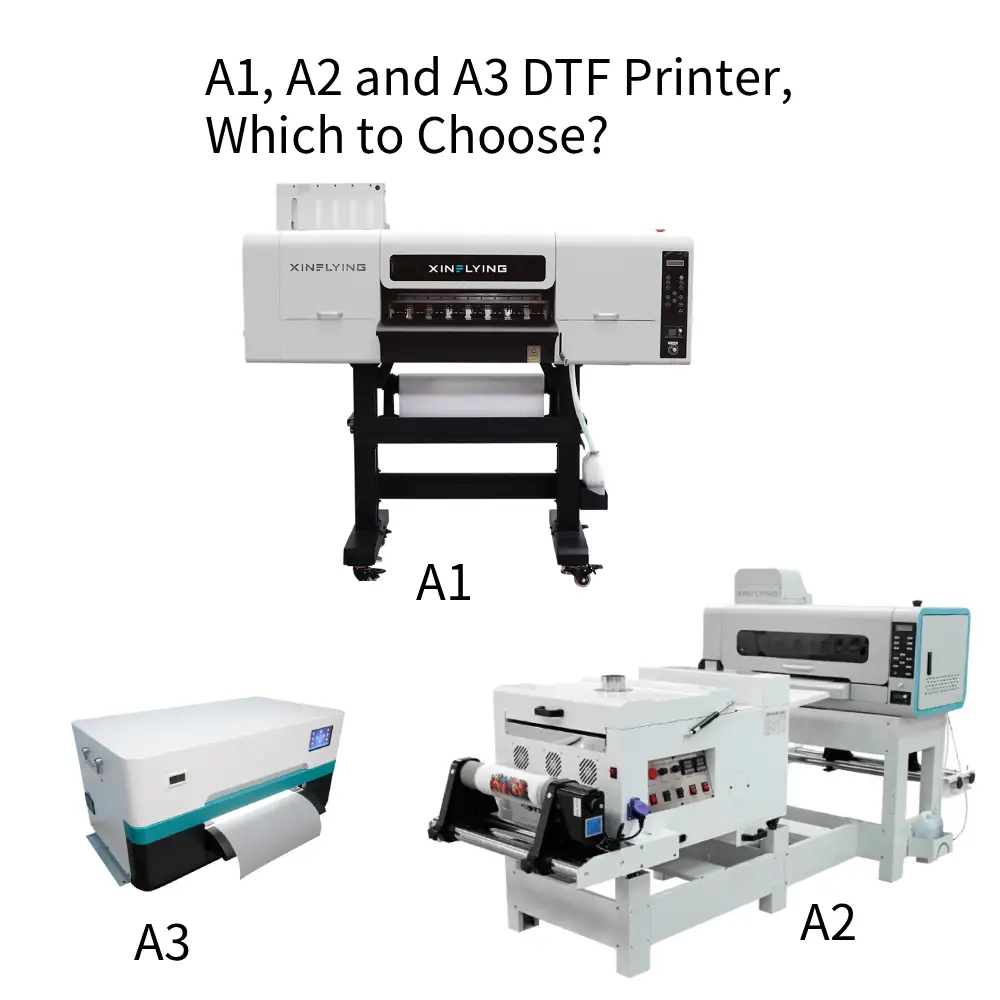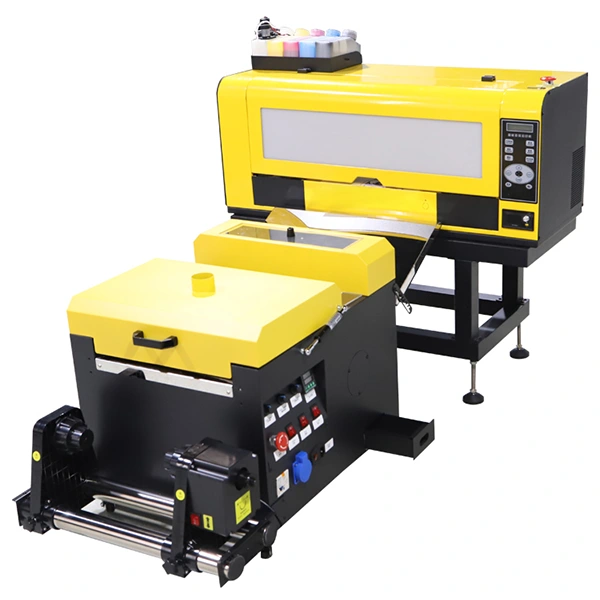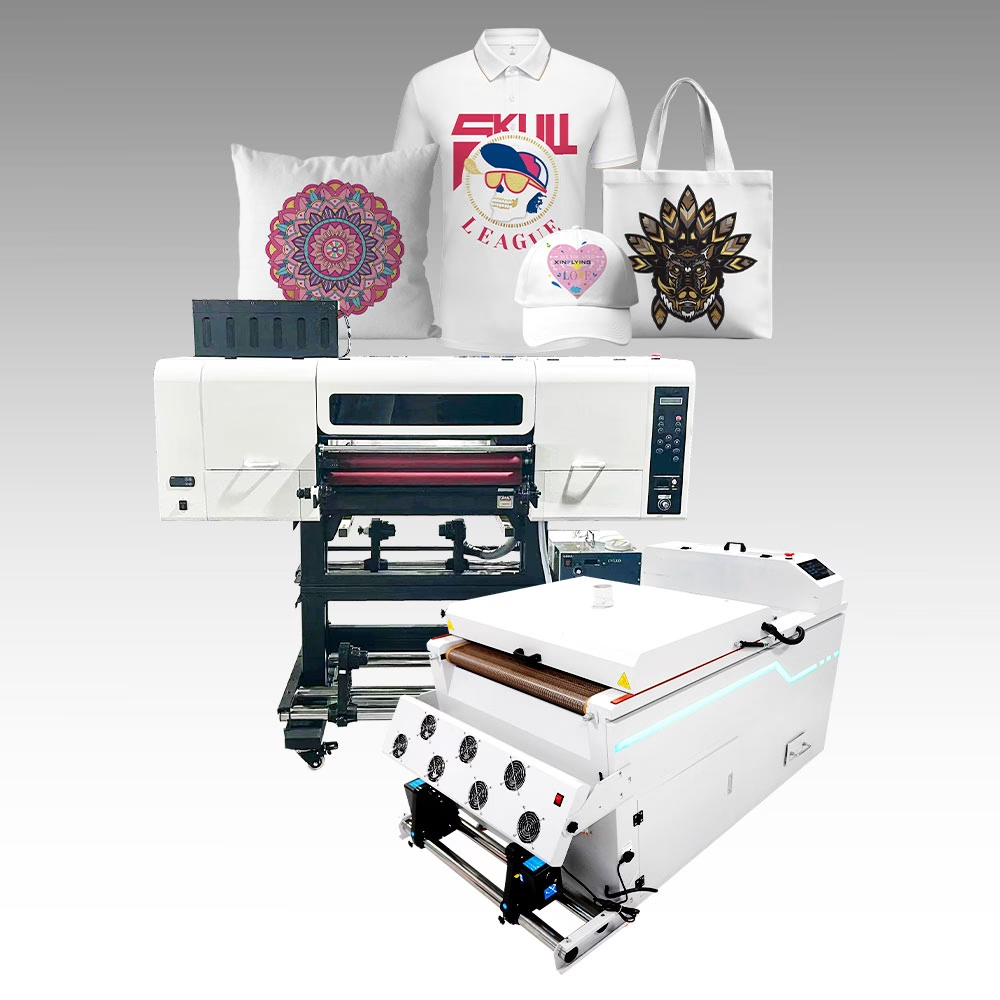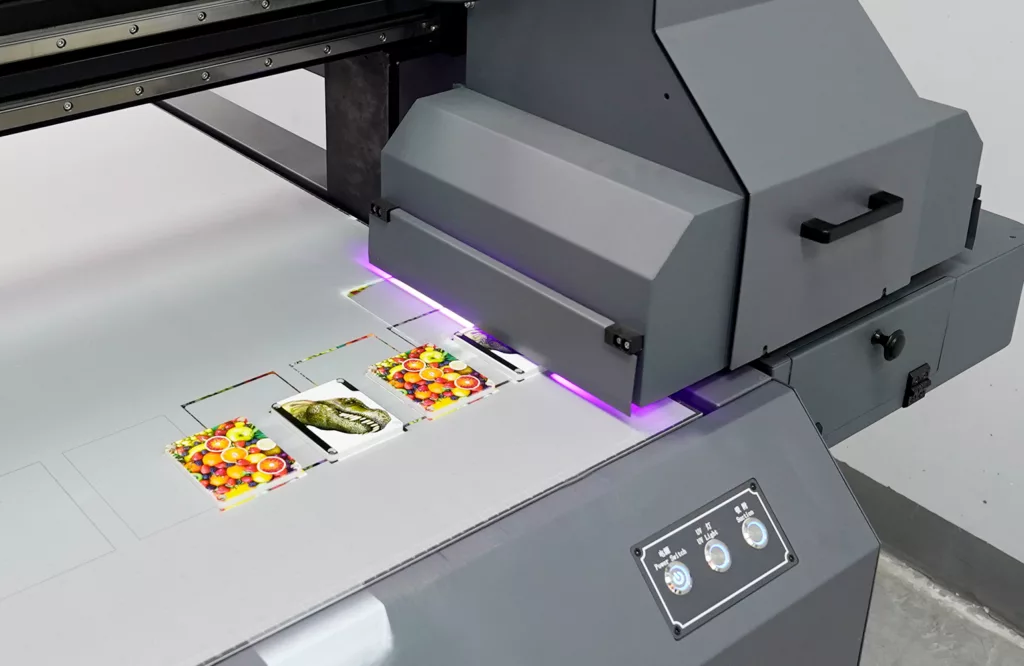Udskrivningsteknologi er nået langt, Tilbyder forskellige metoder til at bringe billeder til live på forskellige overflader. To populære udskrivningsteknikker i branchen i dag er UV DTF -udskrivning og DTF -udskrivning. Mens begge metoder tilbyder imponerende resultater, De har forskellige funktioner, der adskiller dem. I denne artikel, Vi vil gå i dybden med detaljerne i hver udskrivningsmetode, Sammenlign deres styrker og begrænsninger, og give vejledning om at vælge den rigtige udskrivningsmetode til dine behov.
Hvad er UV DTF-udskrivning?
UV DTF print, Kort til ultraviolet direkte til filmudskrivning, er en avanceret teknologi, der giver mulighed for billedoverførsler af høj kvalitet på forskellige underlag. I modsætning til traditionelle trykmetoder, UV DTF print Anvender Ultraviolet (UV) Blæk, der hærdes med UV -lys for enestående holdbarhed og livlige farver.
Sådan bruges UV DTF -printer?
Trin 1: Design på RIP-softwaren
For det første, Forbered kunstværket med RIP -software på computeren. Placer derefter UV DTF en film på platformen for UV DTF -printeren.
Trin 2: Print på film
Forfyld patronen med CMYK-blæk, hvid blæk, og lak til at printe dit design på UV DTF A-filmen.
Trin 3: Lamineret B -film
Sæt den trykte en film i lamineringsmaskinen for at holde den med B -filmen.
Trin 4: Placer film på produkter
Pil A-filmen af mønsteret og sæt den på det emne, du vil printe. Træk derefter langsomt B-filmen af, og dit produkt er færdigt.
Fordele og ulemper ved UV DTF-udskrivning

Fordele ved UV DTF-udskrivning
- Høj billedkvalitet og skarphed
UV DTF -udskrivning tilbyder enestående billedkvalitet med skarpe detaljer og livlige farver. UV -blækene har en bred farveudvalg, giver mulighed for nøjagtig farvegengivelse.
- Bred farveudvalg
UV DTF -udskrivning gør det muligt at trykt en lang række farver på forskellige underlag, resulterer i rige og livlige design.
- Hurtig produktionstid
Sammenlignet med traditionelle udskrivningsmetoder, UV DTF -udskrivning tilbyder hurtigere produktionstider. UV -blækene tørre næsten øjeblikkeligt, Fjernelse af behovet for forlængede tørringsperioder.
- Evne til at udskrive på forskellige underlag
UV DTF -udskrivning giver fleksibiliteten til at udskrive på en lang række materialer, inklusive stoffer, plastik, glas, og mere. Denne alsidighed gør det til et ideelt valg for virksomheder, der ønsker at diversificere deres produkttilbud.
Begrænsninger af UV DTF -udskrivning
- Omkostninger ved UV -blæk og udstyr
UV DTF -udskrivning kræver specialiserede UV -blæk og udstyr, som kan være dyrere sammenlignet med traditionelle udskrivningsmaterialer. Derudover, UV -blæk kan have en kortere holdbarhed, kræver hyppige udskiftninger.
- Begrænset fleksibilitet med visse materialer
Mens UV DTF -udskrivning kan anvendes på forskellige underlag, Nogle materialer er muligvis ikke egnede på grund af deres struktur eller overfladesammensætning. Det er vigtigt at teste udskrivning på forskellige materialer, før de forpligter sig til storstilet produktion.
- Vedligeholdelse og vedligeholdelsesbehov
UV DTF -udskrivningsudstyr kræver regelmæssig vedligeholdelse og vedligeholdelse for at sikre ensartet ydelse. Dette inkluderer rengøring af printerhoveder og sikring af optimale betingelser for UV -hærdning.
Hvad er DTF-udskrivning?
DTF udskrivning, eller Direkte til filmudskrivning, er en teknik, der involverer udskrivning af design på en film ved hjælp af specialiserede blæk, som senere overføres til det ønskede underlag.
Sådan bruges DTF -printer?
Trin 1: Design på RIP-softwaren
Ligner UV DTF -udskrivning, Design kunstværket ved hjælp af grafisk designsoftware, at sikre, at det ønskede design og billedkvalitet opnås.
Trin 2: Udskriv på kæledyrsfilmen
Indsæt kæledyrsfilmen i DTF printer bakker og start udskrivning. Så vil designmønsteret blive overført på det.
Trin 3: Bindblæk med pulver
Med en pulverrystemaskine, de DTF -klæbende pulver kan sprede sig jævnt på kæledyrsfilmen og tørre grafikken.
Trin 4: Overførselsmønster på tekstil
Placer DTF PET -filmen på toppen af substratet, og overfør designet ved hjælp af varmepressemaskine.
Fordele og ulemper ved DTF -udskrivning

Fordele ved DTF -udskrivning
- Omkostningseffektiv udskrivningsmetode
DTF-udskrivning betragtes som omkostningseffektiv, Primært på grund af dets lavere udstyr og blækomkostninger sammenlignet med UV DTF -udskrivning. Dette gør det tilgængeligt for små virksomheder og enkeltpersoner, der ønsker at vove sig ind i trykbranchen.
- Alsidighed med hensyn til kompatible underlag
Som UV DTF -udskrivning, DTF -udskrivning muliggør udskrivning på forskellige underlag, inklusive stoffer, keramik, plastik, og mere. Denne alsidighed udvider udvalget af produkter, der kan produceres ved hjælp af DTF -udskrivning.
- Evne til at opnå livlige farver og fine detaljer
DTF -udskrivning kan opnå livlige og levende farver, såvel som fine detaljer, Gør det velegnet til komplicerede design og komplekse kunstværker.
- Let at bruge og rengøre
DTF-printere er brugervenlige, kræver minimal opsætning og vedligeholdelse. Derudover, Rengøringsprocessen er relativt enkel, Tilladelse af glattere drift og reduceret nedetid.
Begrænsninger af DTF -udskrivning
- Begrænset farveudvalg sammenlignet med UV DTF
Mens DTF -udskrivning kan opnå livlige farver, Dens farveudvalg kan være smalere sammenlignet med UV DTF, Begrænsning af udvalget af nuancer og toner, der kan gengives.
- Længere produktionstid
DTF -udskrivning kan kræve yderligere trin til overførsel af designet til underlaget, hvilket kan resultere i længere produktionstider sammenlignet med UV DTF -udskrivning.
- Kan kræve yderligere trin til visse stoffer
Visse stoffer kan kræve forbehandlingsprocesser, før de udskrives med DTF -blæk. Dette kan tilføje kompleksitet og tid til den samlede udskrivningsproces.
UV DTF vs DTF: En sammenligning

EN. Sammenligning af trykkvalitet
Opløsning og skarphed
Både UV DTF- og DTF-udskrivning kan opnå tryk i høj opløsning med skarpe detaljer. Imidlertid, UV DTF -udskrivning kan give lidt skarpere resultater på grund af UV -hærdningsprocessen, hvilket forbedrer blækpragten.
Farve nøjagtighed og livlighed
UV DTF -udskrivning tilbyder generelt en bredere farveudvalg, Tilladelse af mere nøjagtig farvegengivelse og levende design. DTF udskrivning, mens han er i stand til livlige farver, kan have begrænsninger i at opnå visse nuancer og toner.
B. Typer af substrater
Stofmuligheder
Både UV DTF og DTF -udskrivning kan bruges til at udskrive på forskellige typer stoffer, inklusive bomuld, polyester, og blandinger. Imidlertid, DTF-udskrivning kan kræve yderligere trin eller forbehandling for visse stoffer for at sikre optimal blækadhæsion.
Udskrivning på hårde overflader
Når det kommer til udskrivning på hårde overflader som glas, plast, eller keramik, UV DTF -udskrivning er det foretrukne valg. UV -hærdningsprocessen sikrer fremragende blækadhæsion og holdbarhed på disse overflader.
C. Produktionshastighed og effektivitet
UV DTF -udskrivning tilbyder hurtigere produktionstider sammenlignet med DTF -udskrivning. Den øjeblikkelige tørring af UV DTF -blæk eliminerer behovet for forlængede tørringsperioder, muliggør mere effektiv arbejdsgang.
D. Omkostningssammenligning
UV DTF -udskrivning har generelt højere omkostninger på forhånd på grund af de specialiserede UV -blæk og udstyr, der kræves. DTF udskrivning, på den anden side, tilbyder et mere omkostningseffektivt indgangspunkt for dem, der starter deres
Udskrivningsventurer.
E. Vedligeholdelse og vedligeholdelsesbehov
Både UV DTF- og DTF -udskrivningsudstyr kræver regelmæssig vedligeholdelse og vedligeholdelse. Imidlertid, UV DTF -printere kan kræve hyppigere rengørings- og blækudskiftninger på grund af arten af UV -blæk.
DTF vs UV DTF, Hvilket er bedre?
| Type | DTF udskrivning | UV DTF udskrivning |
| Teknologi | Udskriv på en film, der derefter er varmepresset på materialet. | Kombinerer DTF -teknologi med UV -lys for øjeblikkeligt at helbrede blækket. |
| Blæk | Bruger CMYK+ hvid blæk, Trykt på en klar kæledyrsfilm. | Bruger UV -blæk, Trykt på en klar kæledyrsfilm. |
| Anvendelse | Bomuld, polyester, Bomuldspoly blandinger, læder, nylon, og mere. | Bomuld, polyester, Bomuldspoly blandinger, læder, nylon, plast, træ, metal, og endda glas, og mere. |
| Detalje | Meget høj billedkvalitet og detaljer. | Høj billedkvalitet og detaljer, Selvom UV -processen kan påvirke den lidt. |
| Holdbarhed | Meget holdbar, men varer måske ikke så længe som UV DTF. | Meget holdbar, UV -processen udvider trykt levetid. |
DTF vs UV DTF -sammenligningstabel
Hvornår skal du vælge UV DTF -udskrivning
UV DTF-udskrivning er et passende valg for virksomheder eller enkeltpersoner, der leder efter tryk af høj kvalitet med livlige farver og skarpe detaljer. Det er ideelt til dem, der prioriterer hurtigere produktionstider, har behov for udskrivning på hårde overflader, og kan rumme de oprindelige højere omkostninger.
Hvornår skal man vælge DTF -udskrivning
DTF-udskrivning er en omkostningseffektiv mulighed for dem, der starter i trykbranchen. Det tilbyder alsidighed med hensyn til kompatible underlag og er relativt let at bruge og vedligeholde. DTF -udskrivning anbefales til dem, der prioriterer omkostningseffektivitet, Alsidighed i trykningsmaterialer, og enkelhed i drift.
Valg af den rigtige udskrivningsmetode

Ønsket udskrivningskvalitet
Overvej niveauet for billedskarphed, farvenøjagtighed, og vibration kræves til dine udskrifter. UV DTF -udskrivning udmærker sig i disse områder, Mens DTF-udskrivning tilbyder en mere omkostningseffektiv mulighed med respektabel trykkvalitet.
Type materialer, der skal udskrives på
Tag hensyn til mangfoldigheden af substrater, du planlægger at udskrive på. Hvis du forventer et behov for udskrivning på hårde overflader eller materialer, der kan kræve forbehandling, UV DTF -udskrivning er det bedre valg.
Produktionsmængder og frister
Hvis du har strenge produktionsfrister eller krav til højvolumenprint, UV DTF -udskrivningens hurtige produktionstid kan være mere velegnet. Imidlertid, Hvis produktionsmængder ikke er et primært problem, DTF -udskrivning tilbyder et dygtigt alternativ.
Tilgængeligt budget
Overvej dit tilgængelige budget for udstyr, Blæk, og vedligeholdelse. UV DTF -udskrivning kræver generelt en højere forhåndsinvestering, Mens DTF-udskrivning præsenterer et mere omkostningseffektivt indgangspunkt. Også, Det er vigtigt at vælge en pålidelig stofprinterproducent.
Konklusion
Som konklusion, UV DTF -udskrivning og DTF -udskrivning er to forskellige metoder, der tilbyder enestående billedkvalitet og alsidighed.
UV DTF -udskrivning udmærker sig i form af livlige farver, skarpe detaljer, og evnen til at udskrive på forskellige underlag, Gør det ideelt til virksomheder med højere budgetallokeringer og specifikke udskrivningsbehov. DTF udskrivning, på den anden side, Tilbyder et omkostningseffektivt indgangspunkt for små virksomheder og enkeltpersoner, der søger alsidighed, Enkelhed, og brugervenlighed.
I sidste ende, Valget mellem UV DTF -udskrivning og DTF -udskrivning afhænger af faktorer, såsom trykkrav, Substratdiversitet, produktionsmængder, og tilgængeligt budget. Ved at overveje disse faktorer og forstå styrker og begrænsninger for hver metode, Du kan tage en informeret beslutning og opnå fremragende udskrivningsresultater.
































